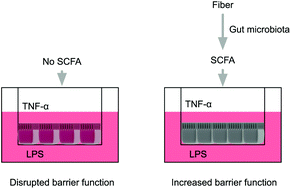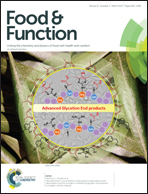Dietary fibre-based SCFA mixtures promote both protection and repair of intestinal epithelial barrier function in a Caco-2 cell model
Abstract
Impaired gut barrier function plays an important role in the development of many diseases such as obesity, inflammatory bowel disease, and in HIV infection. Dietary fibres have been shown to improve intestinal barrier function through their fermentation products, short chain fatty acids (SCFAs), and the effects of individual SCFAs have been studied. Here, different SCFA mixtures representing possible compositions from fibre fermentation products were studied for protective and reparative effects on intestinal barrier function. The effect of fermentation products from four dietary fibres, i.e. resistant starch, fructooligosaccharides, and sorghum and corn arabinoxylan (varying in their branched structure) on barrier function was positively correlated with their SCFA concentration. Pure SCFA mixtures of various concentrations and compositions were tested using a Caco-2 cell model. SCFAs at a moderate concentration (40–80 mM) improved barrier function without causing damage to the monolayer. In a 40 mM SCFA mixture, the butyrate proportion at 20% and 50% showed both a protective and a reparative effect on the monolayer to disrupting agents (LPS/TNF-α) applied simultaneously or prior to the SCFA mixtures. Relating this result to dietary fibre selection, slow fermenting fibres that deliver appropriate concentrations of SCFAs to the epithelium with a high proportion of butyrate may improve barrier function.



 Please wait while we load your content...
Please wait while we load your content...